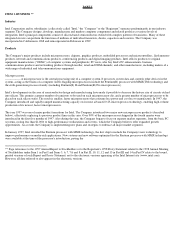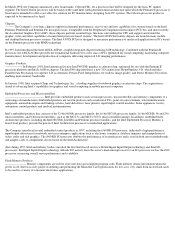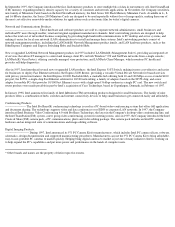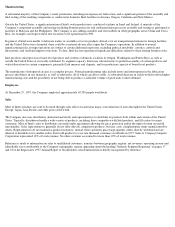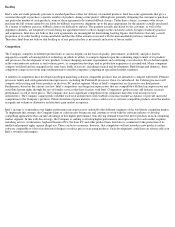Intel 1997 Annual Report Download - page 4
Download and view the complete annual report
Please find page 4 of the 1997 Intel annual report below. You can navigate through the pages in the report by either clicking on the pages listed below, or by using the keyword search tool below to find specific information within the annual report.
PART I
ITEM 1. BUSINESS **
Industry
Intel Corporation and its subsidiaries (collectively called "Intel," the "Company" or the "Registrant") operates predominantly in one industry
segment. The Company designs, develops, manufactures and markets computer components and related products at various levels of
integration. Intel's principal components consist of silicon-based semiconductors etched with complex patterns of transistors. Many of these
integrated circuits can perform the functions of millions of individual transistors, diodes, capacitors and resistors. The Company was
incorporated in California in 1968 and reincorporated in Delaware in 1989.
Products
The Company's major products include microprocessors, chipsets, graphics products, embedded processors and microcontrollers, flash memory
products, network and communications products, conferencing products and digital imaging products. Intel sells its products to original
equipment manufacturers ("OEMs") of computer systems and peripherals; PC users, who buy Intel's PC enhancements, business
communications products and networking products through reseller, retail and OEM channels; and other manufacturers, including makers of a
wide range of industrial and telecommunications equipment.
Microprocessors.
---------------- A microprocessor is the central processing unit of a computer system. It processes system data and controls other devices in the
system, acting as the brains of a computer. Intel's flagship microprocessors include the Pentium(R) processor with MMX(TM) technology and
the sixth-generation processor family (including Pentium(R) II and Pentium(R) Pro microprocessors).
Intel's developments in the area of semiconductor design and manufacturing have made it possible to decrease the feature size of circuits etched
into silicon. This permits a greater number of transistors to be used on each microprocessor die, and a greater number of microprocessors to be
placed on each silicon wafer. The result is smaller, faster microprocessors that consume less power and cost less to manufacture. In 1997, the
Company introduced and rapidly ramped manufacturing capacity on its most advanced 0.25-micron process technology, enabling high-volume
production of its newest, fastest microprocessors.
The year 1997 was one of major product transitions for Intel. The Company introduced two major new microprocessor products (described
below), effectively replacing its previous product lines in this area. Over 90% of the microprocessors shipped in the fourth quarter were
introduced in the first five months of 1997. Also during the year, the Company began to focus on separate market segments, from the basic PC
(systems costing less than $1,000) to high-performance workstations and servers, which the Company believes offer expanded growth
opportunities. As a result, the Company is implementing new plans and strategies to embrace all major market segments.
In January 1997, Intel unveiled the Pentium processor with MMX technology, the first chip to include the Company's new technology to
improve performance on media-rich applications. New systems and new software optimized for the Pentium processor with MMX technology
were available at the time of the processor's introduction, paving the
** Page references to the 1997 Annual Report to Stockholders or to the Registrant's 1998 Proxy Statement related to the 1998 Annual Meeting
of Stockholders under Item 1 in Part I and Items 5, 6, 7, 7A and 8 in Part II; 10, 11, 12 and 13 in Part III and 14 in Part IV relate to the bound,
printed versions of such Report and Proxy Statement, not to the electronic versions appearing at the Intel Internet site (www.intel.com).
However, all data referred to also appears in the electronic versions.




